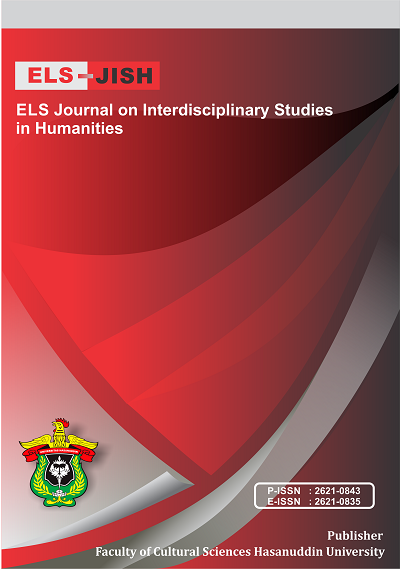The Effectiveness of Using Kinect-Based Dyslexia Therapy in Improving Reading Ability in Dyslexic Children: A Linguistic Study
DOI:
https://doi.org/10.34050/elsjish.v5i3.23168Keywords:
Dyslexia, Kinect-based, LexiPal, Linguistics, TherapyAbstract
Dyslexia is a learning disorder characterized by difficult in reading, writing, or spelling. People especially children with dyslexia have difficult to identify spoken words and converting them into letters or sentences. The aims of this study are 1) to find out the early symptoms of dyslexia in children, 2) to reveal the effectiveness of using video game media (kinect-based dyslexia therapy media) in improving reading skills in dyslexic children. This research used quantitative method. This research is an experimental longitudinal because there is an intensive observation of the subject within a certain period of time. The result of this study is to reduce the dyslexia children as much as possible to read by using the intervention “Kinect-Based Dyslexia Therapy” (LexiPal). Strong evidence of the success of the LexiPal intervention can be seen through the experimental method (calculated the difference in the position of the treatment group and the control group at the end of the experiment). Calculations are carried out through simple statistical calculations.
References
Anna. (2003). An fMRI InvestigationBasso,Aphasia and It’s Therapy. New York: Oxford University Press.
Akbar, M., Amusroh, R. F., Basri, M. I., Tammasse, J., & Bahar, A. (2021). A validity and reliability study of Parkinson Disease Sleep Scale 2 (PDSS-2) in Parkinson disease patient with sleep disorder. Medicina Clínica Práctica, 4, 100216.
Bakker. (1987). Individualized Quantification of Brain-Amyloid Burden: Results of a Proof of Mechanism Phase Florbetaben PET Trial in Patients with Alzheimer’s Disease and Healthy Controls. Eur J. Nucl Med Mol Imaging; 38,1702–1714.
Nation K., Cocksey J., Taylor J.S.H. (2010). Bishop D.V.M.A. Longitudinal Investigation of Early Reading and Language Skills in Children with Poor Reading Comprehension. Journal of Child Psychology and Psychiatry, 51(9):1031–9.
Gobin, (1980). Sex differences in developmental reading disability: new findings from 4 epidemiological studies. JAMA: Journal of the American Medical Association. 291(16)–12.
Gupta A, Singhal G. (2011). Understanding Aphasia in a simplified Manner, Journal Indian Academy of Clinical Medicine.
Hani'ah, M. (2015). Kisah Inspiratif Anak-anak Autis Berprestasi. Jakarta: Diva Press.
Harrar. (2014). Improved Probabilistic Inference as a General Learning Mechanism with Action Video Games.Curr. Biol. 20, 1573-1579.
Kemmerer, D. (2014). Neurolinguistics: Mind, Brain, and Language Department of Speech, Language, and Hearing Sciences; Department of Psychological Sciences Purdue University, West Lafayette, IN 47906, USA kemmerer@purdue.edu.
Nahliah & Rahman, F. (2018). Glossophobia in training of speech. ELS Journal on Interdisciplinary Studies in Humanities, 1(1), 28-36.
Ritonga, S. N. A., Nasmilah, N., & Rahman, F. (2020). The effect of motivation and anxiety on students’ speaking performance: a study at Dayanu Ikhsanuddin university. ELS Journal on Interdisciplinary Studies in Humanities, 3(2), 198-213.
Robin. (2012). Neural systems for compensation and persistence: Young adultoutcome of childhood reading disability. Biological Psychiatry, 54(1):25–3.
Shaywitz, S. , Bennett. (2006). Dyslexia, In: K.F. Swaiman, S. Ashwal, D.M. Ferreier (penyunting).Pediatric Neurology Principles and Practice, 1, 4th edition. Mosby, Philadelphia.
Sidiarto. (2007). Perkembangan Otak dan Kesulitan Belajar pada Anak. Jakarta: UI Press.
Solek & Dewi, K. (2013). Dyslexia Today, Genius Tomorrow. Bandung: Dyslexia Association of Indonesia Production.
Sukmawaty, Rahman, F. F. & Andini, C. (2022). Covid-19 Pandemic and Axiology of Communication: A Study of Linguistic Phenomena. IJISRT, 7(4).
Tammasse, J., Akbar, M., & Basri, M. I. (2021). The influence of repetitive transcranial magnetic stimulation toward improvement of post ischemic stroke patient's quality of sleep. Medicina Clínica Práctica, 4, 100203.
Tammasse, Tammasse, J. Rahman, F. (2019). Some difficulties in verbalizing English words and phrases: A case study of suspected dyslexic children. Asian EFL Journal Research Articles,6(26) 73-85.
Lyytinen, P. (2005). Language Development and Literacy Skills in Late Talking Toddlers with and without Familial Risk for Dyslexia. Annuals of Dyslexia. 55(2),166‐192.
Wood, C. P. (2006): The Eye Movements of Dyslexic Children During Reading and Visual Search: Impact of the Visual Attention Span.
Downloads
Published
Issue
Section
License
Copyright (c) 2022 Tammasse Tammasse, Jumraini Tammasse, Iin Fadhilah Utami, Fakhriawan Fathu Rahman

This work is licensed under a Creative Commons Attribution-NonCommercial-ShareAlike 4.0 International License.






